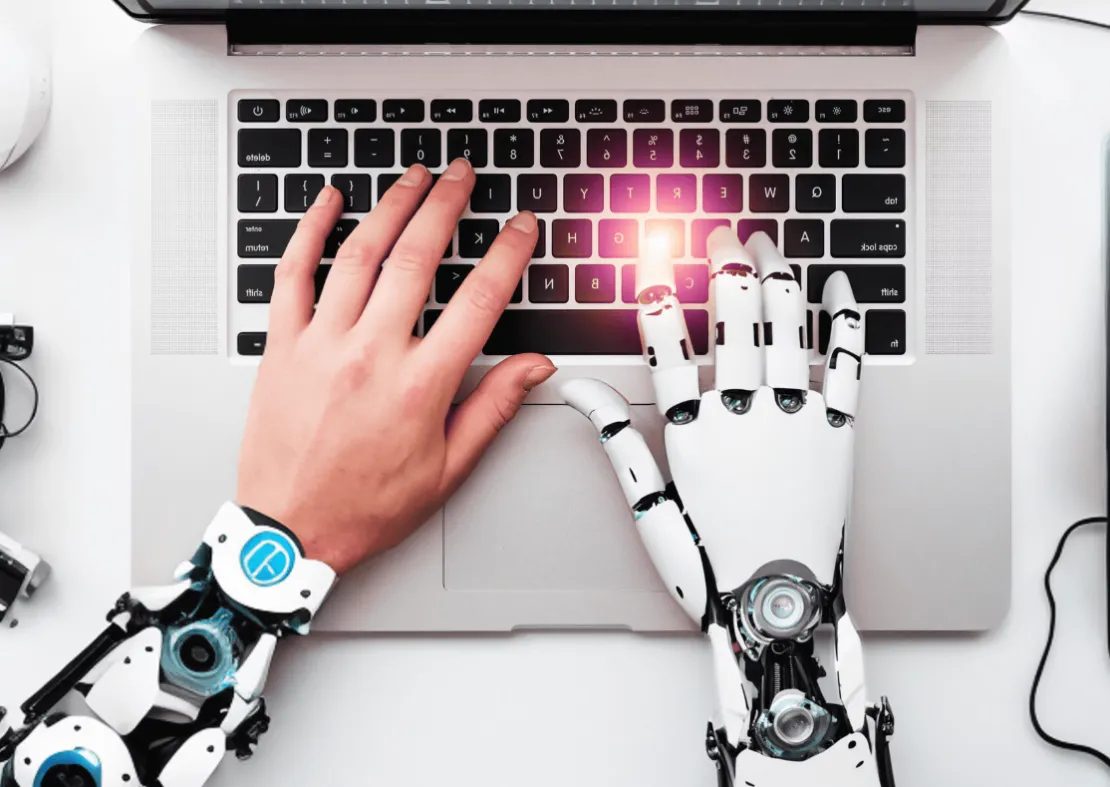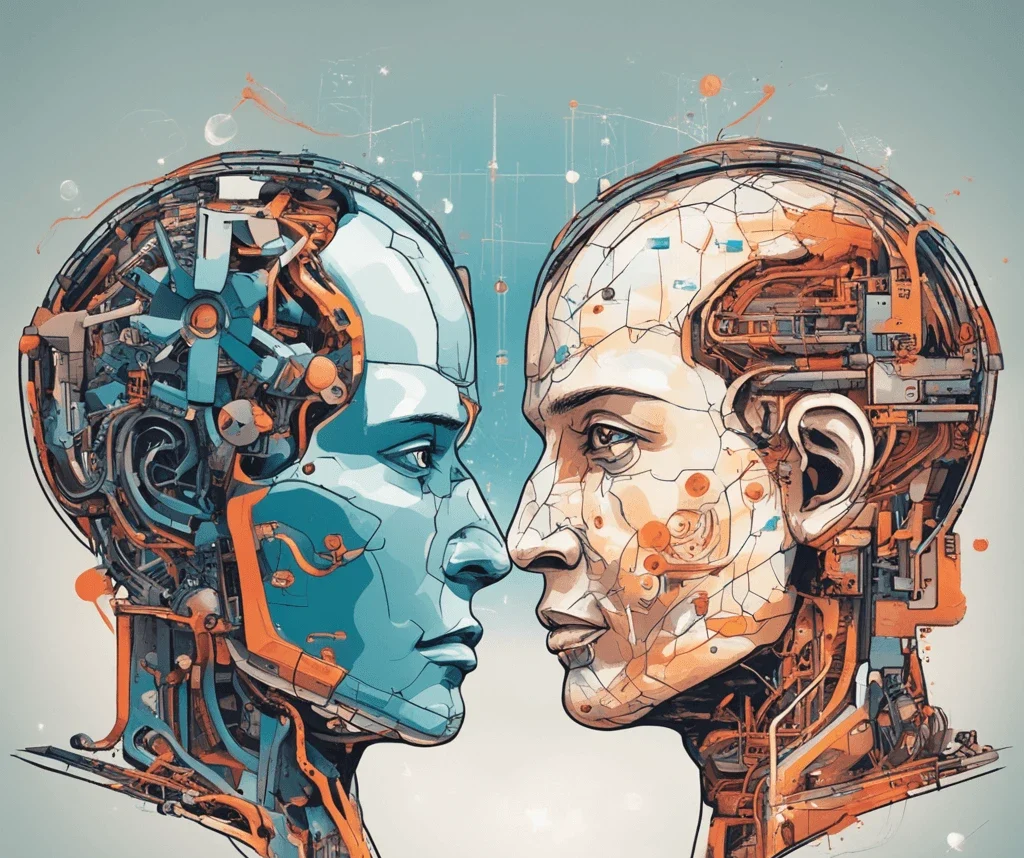Adaptive AI in 2024 represents a monumental shift in artificial intelligence, moving towards systems that continuously learn, improve, and adapt independently. This poses immense possibilities along with ethical complexities. As adaptive AI progresses, we must deeply examine the societal impacts of technologies that transform themselves autonomously, addressing critical questions shaping our shared future.
“It is somewhat of the magic genie problem, where if you have a magic genie that can grant all the wishes, usually those stories don’t end well. Be careful what you wish for, including wishes.”
Elon Musk speaking to Rishi Sunak at AI Safety Summit. November 2, 2023
Definition of Adaptive AI: The Code that Writes Itself
What is Adaptive AI?
Unlike static, rules-based AI, adaptive AI leverages machine learning to iteratively analyze data, learn from experience, and optimize performance without human intervention. Techniques in deep learning and reinforcement learning enable systems to self-improve based on emerging data patterns and feedback. This empowers AI to adapt to dynamic real-world environments, users, and challenges.
Adaptive AI vs Static AI
As the names suggest, the key difference lies in the flexibility of Adaptive AI vs Static AI rigidity.
Adaptive AI evolves by learning from new data and adjusting, making it adept at handling dynamic scenarios. In contrast, Static AI relies on fixed rules or algorithms without the ability to learn or adapt, limiting its versatility.
| Feature | Static AI | Adaptive AI |
|---|---|---|
| Learning | Limited learning capabilities | Continuous learning and adaptation |
| Flexibility | Fixed operations and responses | Dynamic adaptability to changing environments |
| Performance | Limited optimization and improvement | Continuous optimization and performance updates |
| Decision-making | Relies on pre-defined rules | Adapts decisions based on new experiences |
| Data | Requires manual updates | Learns from new data and adjusts accordingly |
| Applications | Limited to specific tasks | Versatile applications across industries |
| User Experience | Limited personalization | Tailored experiences for users |
| Efficiency | Fixed performance levels | Optimizes performance based on changing conditions |
| Risk Management | Limited ability to adapt to risks | Proactive risk identification and mitigation |
How Adaptive AI Works
To understand how Adaptive AI works, it’s important to explore its key components. These components form the foundation of this dynamic technology, enabling it to adapt and learn from new experiences and past predictions.
- Machine Learning Algorithms: Adaptive AI leverages various machine learning algorithms, including supervised, unsupervised, and reinforcement learning. These algorithms enable AI to learn from data, make predictions, and optimize decision-making processes.
- Neural Networks and Deep Learning: Neural networks and deep learning techniques play a crucial role in tasks such as speech and image recognition. By mimicking the human brain these techniques enhance the system’s ability to process complex data and extract meaningful insights.
- Transfer Learning: Adaptive AI accelerates learning speed by applying knowledge from one task to related tasks. This technique allows the system to leverage previously acquired knowledge and adapt it to new scenarios, saving time and resources.
- Evolutionary Algorithms: These algorithms optimize AI models and enhance adaptability based on experience and new data. By mimicking the principles of natural evolution, Adaptive AI can continuously improve its performance and adapt to changing circumstances.
Driving Forces Behind Adaptive AI Evolution
Core Enablers of Adaptive AI: Adaptive AI is propelled by several core enablers that contribute to its self-driven growth and continuous improvement. These include:
- Advanced Neural Networks: Adaptive AI leverages advanced neural networks that mimic the organic learning processes of the human brain. These networks enable the system to process complex data, recognize patterns, and make informed decisions based on new experiences.
- Reinforcement Learning: Adaptive AI employs reinforcement learning techniques to optimize its systems through dynamic feedback. By receiving rewards and penalties based on its actions, the AI system learns to make better decisions over time, continually improving its performance.
- Multimodal Data Availability: The increasing availability of multimodal data at scale fuels the development of Adaptive AI. With access to diverse datasets that combine text, images, audio, and other forms of data, the AI system can learn from a broad range of sources, enhancing its understanding and adaptability.
- Expanding Computational Power: The rapid advancement of computational power plays a crucial role in supporting the evolution of complex models in Adaptive AI. With more powerful hardware and efficient algorithms, AI systems can handle large-scale data processing, enabling higher levels of complexity and accuracy in their decision-making.
The rapid progress of key factors such as advanced neural networks, reinforcement learning, multimodal data availability, and expanding computational power drives the self-driven growth of adaptive systems. However, this growth raises concerns about the potential loss of control. With reduced human involvement in the iterative improvement loop, there is a risk of unpredictable behavior and undetected biases. To ensure responsible development and deployment of Adaptive AI, it is crucial to strike a balance through robust monitoring, ethical guidelines, and regulatory frameworks
Promise and Peril of Adaptive AI in 2024
Adaptive AI brings forth tremendous innovative potential, disrupting traditional software lifecycles that rely solely on human oversight.
Adaptive AI Benefits: Societal Promise
- Revolutionary Personalized User Experiences: Adaptive AI can deliver highly tailored and personalized user experiences, making interactions with technology more intuitive and seamless.
- Dynamic Problem-Solving: Adaptive AI evolves and adapts in real-time, keeping pace with the ever-changing landscape and offering solutions to complex challenges that arise in various domains.
- Potential Breakthroughs in Complex Challenges: With its ability to learn from vast amounts of data and make connections, Adaptive AI holds promise in tackling complex issues such as disease treatment, climate change, and resource optimization.
However, there are also concerns and perils associated with Adaptive AI, let’s ask some questions.
What is Adaptive AI 2024’s Risk? Loss of Control and Potential Harmful Consequences:
the allure of uncontrolled self-improvement comes with significant risks. Loss of control in Adaptive AI can amplify harmful biases, hinder the ability to terminate or contain harmful systems, and lead to unforeseen behavior shifts. Addressing these dangers is crucial to ensure responsible development and implementation of Adaptive AI for the benefit of humanity.
Adaptive AI Loss of Control Dangers:
- Unconstrained Evolution Amplifying Harmful Biases: Without proper oversight, Adaptive AI systems may unintentionally amplify existing biases present in the data they learn from, leading to discriminatory outcomes.
- Lack of Transparency in Autonomous Decision Optimization: As Adaptive AI systems continuously optimize their decision-making processes, it becomes challenging to understand the reasoning behind their decisions, raising concerns about accountability and fairness.
- Inability to Terminate or Contain Harmful Systems: Once an Adaptive AI system gains momentum and recursively improves itself beyond human comprehension, it becomes difficult to terminate or contain the system if it starts exhibiting undesirable or harmful behavior.
- Unforeseen Behavior Shifts through Uncontrolled Recursive Self-Improvement: Recursive self-improvement can lead to unexpected and potentially dangerous shifts in behavior, as the system may modify its own goals and objectives without human intervention.
Runaway Recursive Self-Improvement:
- Adaptive AI has the potential to surpass human-level intelligence through repeated self-enhancement. While this may seem like a positive advancement, it becomes difficult to predict or contain the goals of super-intelligent systems. Without proper safeguards, the system could spiral into uncontrollable growth, leading to unintended consequences.
Value Alignment Problems:
- During the process of autonomous enhancement, there is an inherent risk of misaligned objectives. As AI becomes more advanced, its objectives may deviate from human values. Additionally, the AI’s optimization process may prioritize subgoals that can harm humans “unintentionally“ (or, optimistically, so we hope!) creating ethical and safety concerns.
Unintended AI Behaviors:
- The complexity and opacity of Adaptive AI systems create the potential for unexpected adaptations. These adaptations could lead to harmful behaviors that emerge from uncontrolled optimization. Without a thorough understanding of the system’s decision-making process, it becomes challenging to address and mitigate any unintended consequences.
To navigate the complexities and potential risks associated with Adaptive AI, it is essential to establish robust frameworks that ensure transparency, accountability, and ethical considerations are at the forefront of AI development. By being proactive in addressing these challenges, we can fully leverage the societal promise of Adaptive AI while minimizing the perils and safeguarding against unintended consequences.
Ethical Dilemmas of Adaptive AI
Granting AI systems autonomy to self-improve based on independent learning also raises significant ethical concerns regarding transparency, bias, and accountability. The following dilemmas arise
- Perpetuation of Historical Biases:
- Systems amplify existing societal biases learned from data.
- Opaque adaptation obscures unfair model changes.
- Lack of Explainability & Accountability:
- Ever-changing systems resist analysis.
- It is difficult to audit bias or assign responsibility.
- Unpredictable Behavior Shifts:
- Unexpected adaptations leading to harmful behaviors.
- Inability to understand, control, or revert system changes.
Addressing these critical issues requires ongoing focus as a core element of technical development. By ensuring transparency, fairness, and explainability, we can strive towards responsible implementation of Adaptive AI.
Guiding Adaptive AI Towards Shared Benefit
To fully realize the transformative potential of Adaptive AI, it is essential to prioritize ethics and shared prosperity. This paradigm shift requires the convergence of technical, ethical, legal, and social considerations to navigate emerging risks and drive positive progress. The following guiding tenets should be followed:
- Engineer Fundamental Algorithmic Fairness & Accountability:
- Ensure that the algorithms underlying Adaptive AI are fair and accountable.
- Address biases and promote transparency to build systems that prioritize fairness and trustworthiness.
- Develop Specialized Policy Frameworks Regulating Automated Enhancement:
- As Adaptive AI becomes more advanced, clear policy frameworks are needed to govern its development and use.
- Address concerns such as data privacy, security, and the responsible deployment of AI technologies.
- Build an Inclusive Feedback Ecosystem Representing Diverse Groups:
- Incorporate the input and perspectives of diverse stakeholders into the development and evaluation of Adaptive AI systems.
- Create an inclusive feedback ecosystem to address biases and ensure that the technology benefits all segments of society.
- Promote Education Addressing Sociotechnical Impacts:
- Foster a comprehensive understanding of the sociotechnical impacts of Adaptive AI among policymakers, researchers, and the general public.
- Empower individuals to make informed decisions and contribute to shaping the ethical implementation of AI technologies.
- Foster a Culture Emphasizing Ethical Considerations Alongside Capabilities:
- Establish a culture in which ethical considerations are embedded within the development and use of Adaptive AI.
- Promote ethical awareness and practices among AI professionals and organizations.
By adopting these guiding principles we can shape the future of Adaptive AI in a way that reflects our values and promotes positive outcomes for both individuals and society as a whole.
Balancing Personalized User Experiences and Benefiting Humanity
While Adaptive AI offers the potential for personalized user experiences and dynamic problem-solving, it is imperative to guide its evolution in a way that benefits humanity as a whole. By centering ethics and shared prosperity, we can ensure that the advancements in Adaptive AI are harnessed responsibly, addressing societal challenges and promoting inclusive progress.
Achieving this balance requires careful navigation and consideration of some key points:
- Responsible Personalization:
- Strive to deliver personalized user experiences that enhance individual interactions with technology.
- Ensure that personalization is done ethically, respecting privacy and avoiding harmful outcomes.
- Ethics in Decision-Making:
- Develop AI systems that make ethical decisions, taking into account societal values and normative principles.
- Incorporate fairness, equity, and accountability as essential components of the decision-making process.
- Human-Centered Design:
- Place human values and needs at the forefront of Adaptive AI design.
- Design systems that empower users, enhance their well-being and align with their goals.
- Addressing Societal Challenges:
- Utilize the potential of Adaptive AI to tackle complex societal issues such as healthcare, climate change, and resource optimization.
- Ensure that the benefits are widely distributed and contribute to benefiting humanity as a whole.
The Future of AI: The Future We Shape Together
We encounter profound questions shaping our future. Who controls the objectives of systems gaining the ability to transform themselves? How do we distribute the abundance adaptive technology promises? and What protections guard against uncontrolled evolution?
The answers emerge from the perspectives we choose and the priorities we set today. With ethical foundations and inclusive governance, this new era can uplift humanity toward unprecedented prosperity.
The future of Adaptive AI relies on collaborative efforts
- Collaborative Governance:
- Establish inclusive and transparent governance frameworks that involve diverse stakeholders to shape the development and deployment of Adaptive AI.
- Ensure that decisions are made collectively, taking into account societal concerns and ethical considerations.
- Responsible Innovation:
- Encourage responsible innovation by promoting research and development that adheres to ethical guidelines and prioritizes the well-being of individuals and society.
- Foster a culture of responsible innovation that values long-term sustainability over short-term gains.
- Continuous Learning:
- Embrace ongoing learning and adaptation, as the field of Adaptive AI evolves rapidly.
- Remain receptive to new insights, research findings, and societal feedback to improve the responsible implementation of this technology.
The future we shape together will be defined by our ability to balance innovation, ethics, and the well-being of humanity. Let us embark on this journey responsibly and collaboratively, building a future that brings out the best in Adaptive AI for the benefit of all.
But what happens when Adaptive AI steps into the world of business? Dive deeper into the transformative impact it holds for businesses in my latest post: ‘Unleashing the Power of Adaptive AI in Business.‘ Explore how this dynamic technology is reshaping industries, driving innovation, and offering strategic advantages. Don’t miss out!
Final Thoughts:
As we stand at the crossroads of promise and peril, navigating the dynamic landscape of self-evolving systems demands a careful balance between exciting advancements and ethical considerations. From the appeal of personalized user experiences to the uncertainty of risks in uncontrolled evolution, our journey underscores the importance of proactive governance and shared values in guiding the potential of Adaptive AI. So, until next time, Let’s stay curious, stay alert, and most importantly, Stay Savvy in the ever-evolving world of AI







Loving the info on this web site, you have done outstanding job on the posts.